Accounting Information System: Analysis and Recommendations
VerifiedAdded on 2022/11/24
|11
|2462
|466
Report
AI Summary
This report delves into the intricacies of Accounting Information Systems (AIS), examining their critical role in modern organizations. It begins by defining the accountant's role in information-intensive environments and then explores how AIS provides crucial data for management decision-making. The report outlines the benefits of information technology to AIS, identifies the components of an AIS, and explains how AIS adds value to an organization. Furthermore, it investigates how a well-designed AIS enhances the efficiency and effectiveness of a company's value chain. The report also discusses the characteristics of useful information, describes the basic tasks performed by AIS, and explores methods for determining the value of information produced by AIS. The report concludes by examining the application of integrated enterprise systems, offering insights for a small grocery store, and identifying the vital functions of accounting system servers.
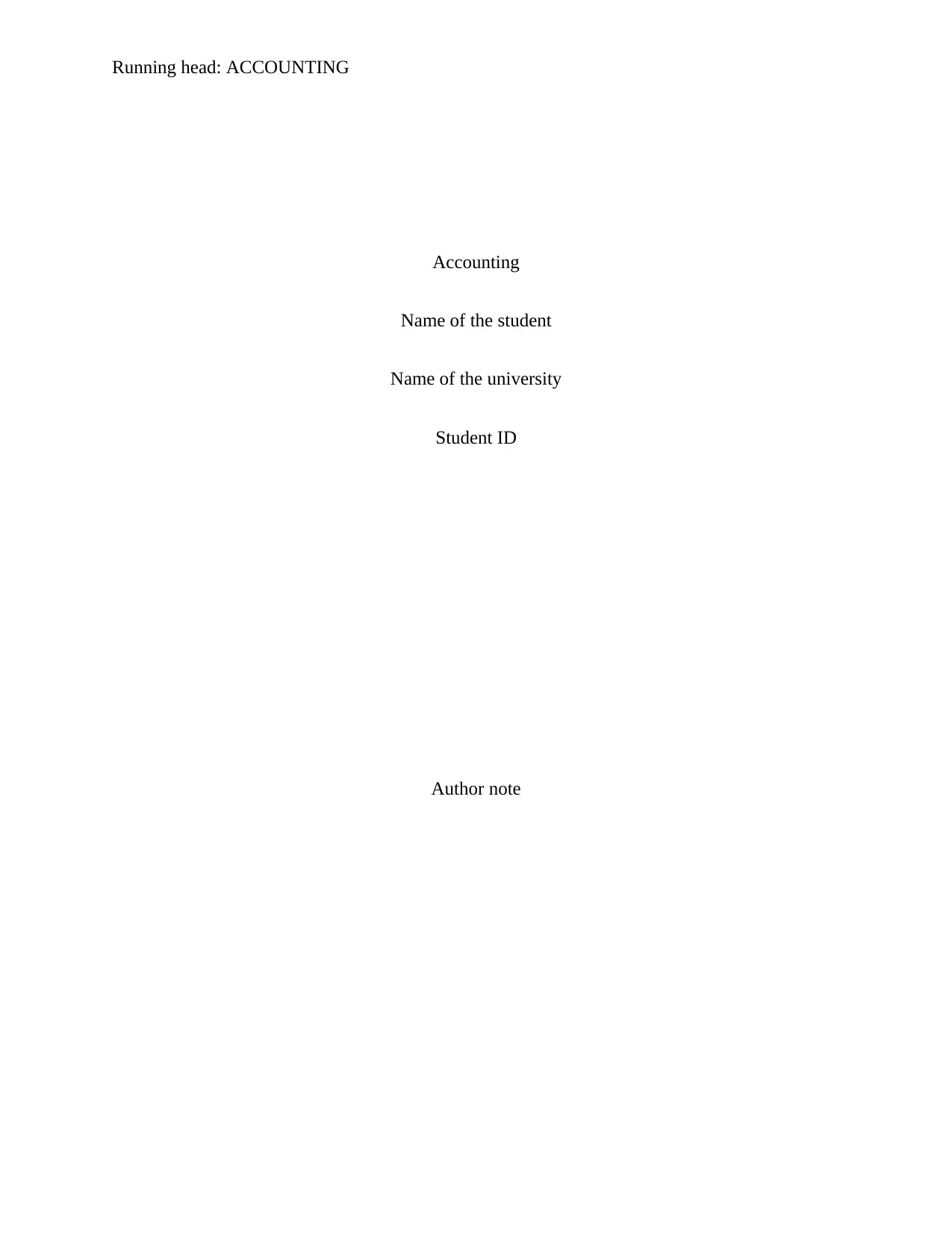
Running head: ACCOUNTING
Accounting
Name of the student
Name of the university
Student ID
Author note
Accounting
Name of the student
Name of the university
Student ID
Author note
Paraphrase This Document
Need a fresh take? Get an instant paraphrase of this document with our AI Paraphraser
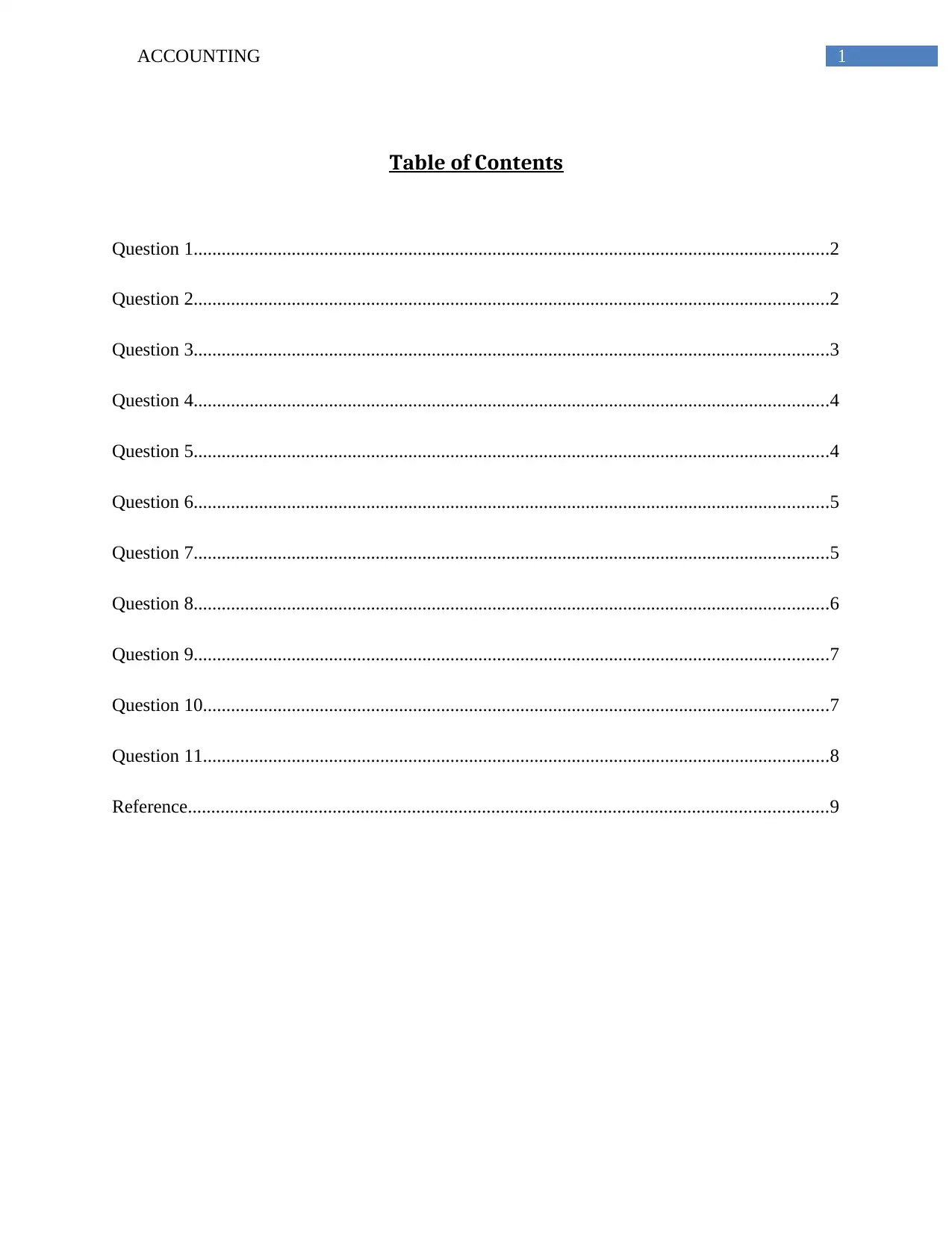
1ACCOUNTING
Table of Contents
Question 1........................................................................................................................................2
Question 2........................................................................................................................................2
Question 3........................................................................................................................................3
Question 4........................................................................................................................................4
Question 5........................................................................................................................................4
Question 6........................................................................................................................................5
Question 7........................................................................................................................................5
Question 8........................................................................................................................................6
Question 9........................................................................................................................................7
Question 10......................................................................................................................................7
Question 11......................................................................................................................................8
Reference.........................................................................................................................................9
Table of Contents
Question 1........................................................................................................................................2
Question 2........................................................................................................................................2
Question 3........................................................................................................................................3
Question 4........................................................................................................................................4
Question 5........................................................................................................................................4
Question 6........................................................................................................................................5
Question 7........................................................................................................................................5
Question 8........................................................................................................................................6
Question 9........................................................................................................................................7
Question 10......................................................................................................................................7
Question 11......................................................................................................................................8
Reference.........................................................................................................................................9
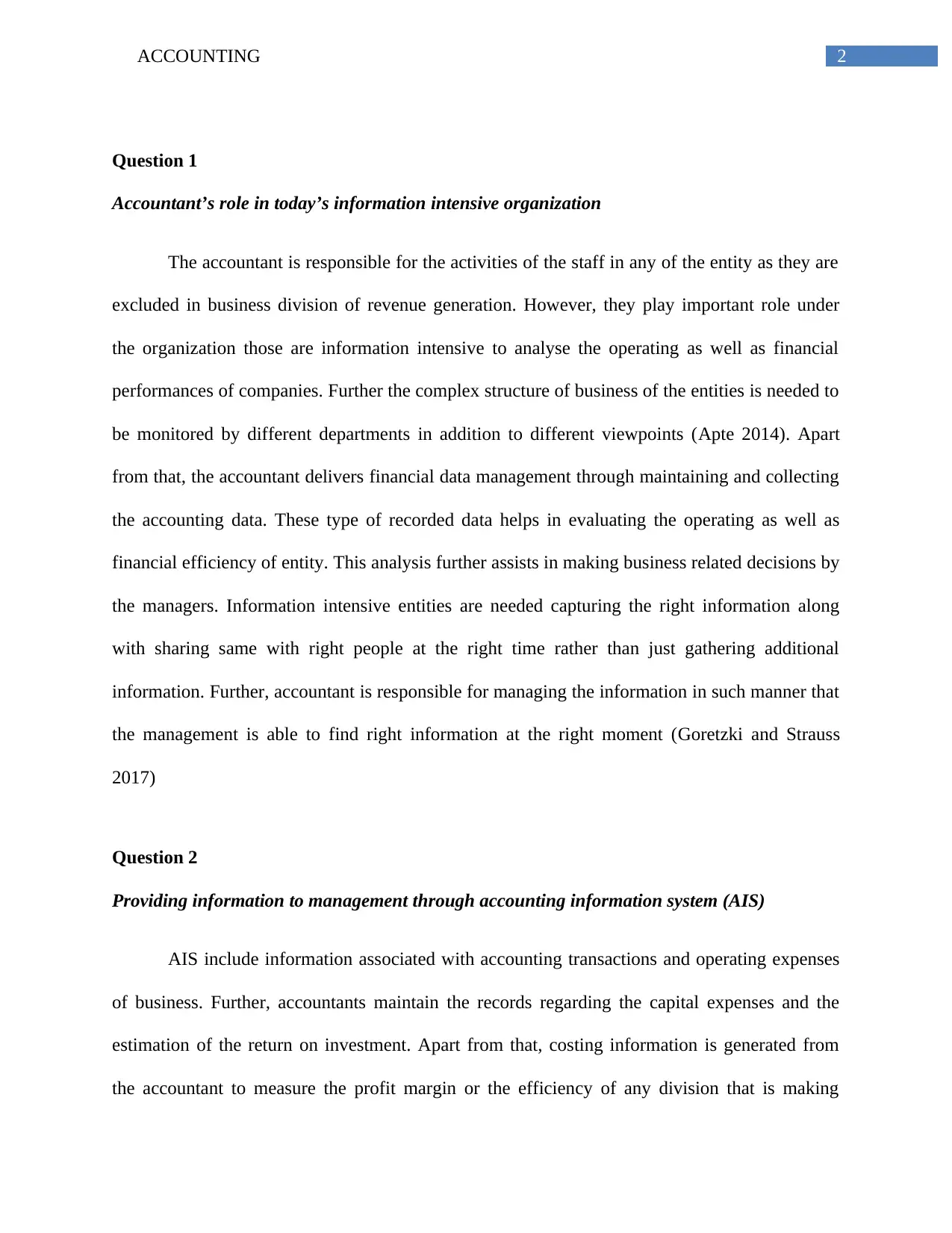
2ACCOUNTING
Question 1
Accountant’s role in today’s information intensive organization
The accountant is responsible for the activities of the staff in any of the entity as they are
excluded in business division of revenue generation. However, they play important role under
the organization those are information intensive to analyse the operating as well as financial
performances of companies. Further the complex structure of business of the entities is needed to
be monitored by different departments in addition to different viewpoints (Apte 2014). Apart
from that, the accountant delivers financial data management through maintaining and collecting
the accounting data. These type of recorded data helps in evaluating the operating as well as
financial efficiency of entity. This analysis further assists in making business related decisions by
the managers. Information intensive entities are needed capturing the right information along
with sharing same with right people at the right time rather than just gathering additional
information. Further, accountant is responsible for managing the information in such manner that
the management is able to find right information at the right moment (Goretzki and Strauss
2017)
Question 2
Providing information to management through accounting information system (AIS)
AIS include information associated with accounting transactions and operating expenses
of business. Further, accountants maintain the records regarding the capital expenses and the
estimation of the return on investment. Apart from that, costing information is generated from
the accountant to measure the profit margin or the efficiency of any division that is making
Question 1
Accountant’s role in today’s information intensive organization
The accountant is responsible for the activities of the staff in any of the entity as they are
excluded in business division of revenue generation. However, they play important role under
the organization those are information intensive to analyse the operating as well as financial
performances of companies. Further the complex structure of business of the entities is needed to
be monitored by different departments in addition to different viewpoints (Apte 2014). Apart
from that, the accountant delivers financial data management through maintaining and collecting
the accounting data. These type of recorded data helps in evaluating the operating as well as
financial efficiency of entity. This analysis further assists in making business related decisions by
the managers. Information intensive entities are needed capturing the right information along
with sharing same with right people at the right time rather than just gathering additional
information. Further, accountant is responsible for managing the information in such manner that
the management is able to find right information at the right moment (Goretzki and Strauss
2017)
Question 2
Providing information to management through accounting information system (AIS)
AIS include information associated with accounting transactions and operating expenses
of business. Further, accountants maintain the records regarding the capital expenses and the
estimation of the return on investment. Apart from that, costing information is generated from
the accountant to measure the profit margin or the efficiency of any division that is making
⊘ This is a preview!⊘
Do you want full access?
Subscribe today to unlock all pages.

Trusted by 1+ million students worldwide
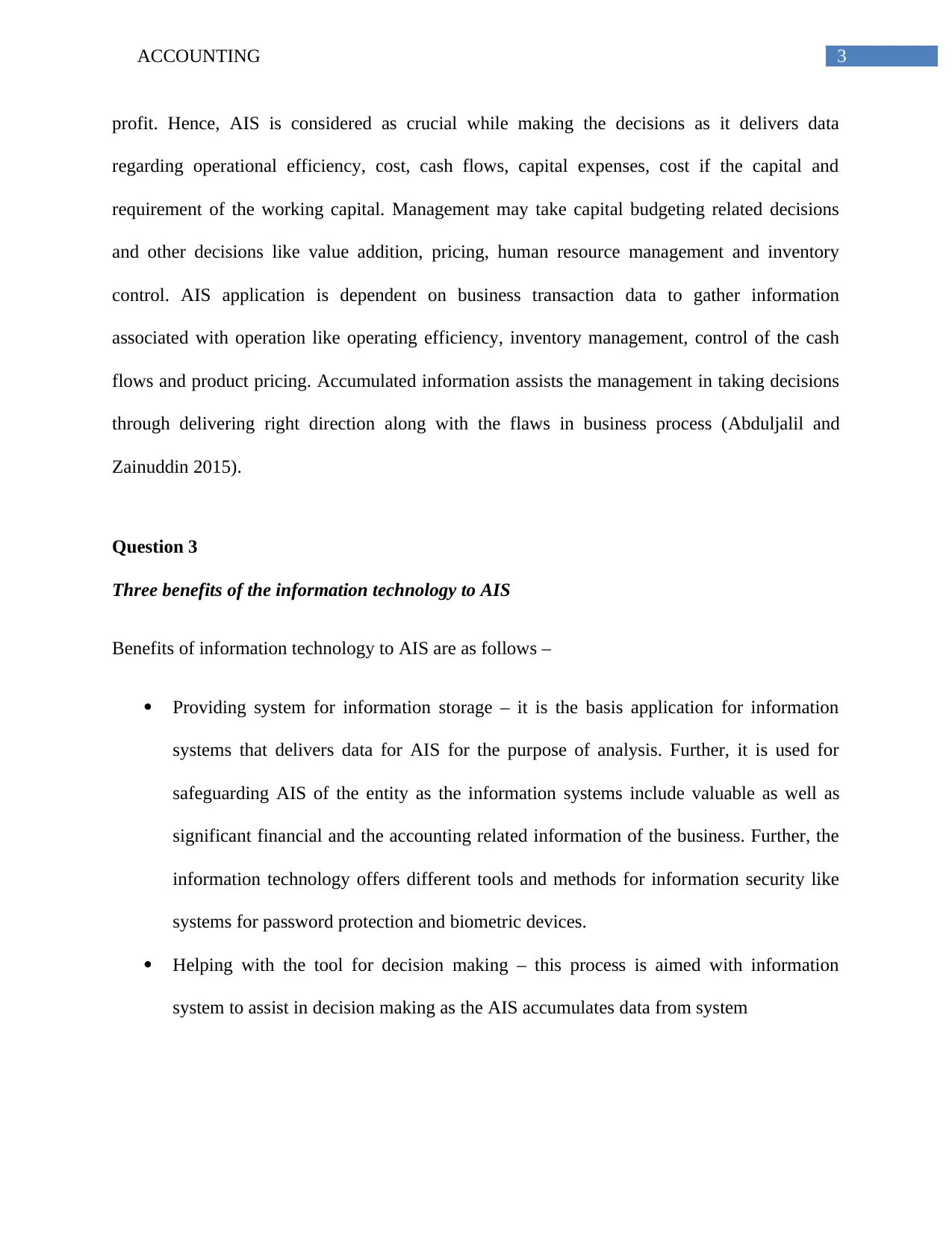
3ACCOUNTING
profit. Hence, AIS is considered as crucial while making the decisions as it delivers data
regarding operational efficiency, cost, cash flows, capital expenses, cost if the capital and
requirement of the working capital. Management may take capital budgeting related decisions
and other decisions like value addition, pricing, human resource management and inventory
control. AIS application is dependent on business transaction data to gather information
associated with operation like operating efficiency, inventory management, control of the cash
flows and product pricing. Accumulated information assists the management in taking decisions
through delivering right direction along with the flaws in business process (Abduljalil and
Zainuddin 2015).
Question 3
Three benefits of the information technology to AIS
Benefits of information technology to AIS are as follows –
Providing system for information storage – it is the basis application for information
systems that delivers data for AIS for the purpose of analysis. Further, it is used for
safeguarding AIS of the entity as the information systems include valuable as well as
significant financial and the accounting related information of the business. Further, the
information technology offers different tools and methods for information security like
systems for password protection and biometric devices.
Helping with the tool for decision making – this process is aimed with information
system to assist in decision making as the AIS accumulates data from system
profit. Hence, AIS is considered as crucial while making the decisions as it delivers data
regarding operational efficiency, cost, cash flows, capital expenses, cost if the capital and
requirement of the working capital. Management may take capital budgeting related decisions
and other decisions like value addition, pricing, human resource management and inventory
control. AIS application is dependent on business transaction data to gather information
associated with operation like operating efficiency, inventory management, control of the cash
flows and product pricing. Accumulated information assists the management in taking decisions
through delivering right direction along with the flaws in business process (Abduljalil and
Zainuddin 2015).
Question 3
Three benefits of the information technology to AIS
Benefits of information technology to AIS are as follows –
Providing system for information storage – it is the basis application for information
systems that delivers data for AIS for the purpose of analysis. Further, it is used for
safeguarding AIS of the entity as the information systems include valuable as well as
significant financial and the accounting related information of the business. Further, the
information technology offers different tools and methods for information security like
systems for password protection and biometric devices.
Helping with the tool for decision making – this process is aimed with information
system to assist in decision making as the AIS accumulates data from system
Paraphrase This Document
Need a fresh take? Get an instant paraphrase of this document with our AI Paraphraser
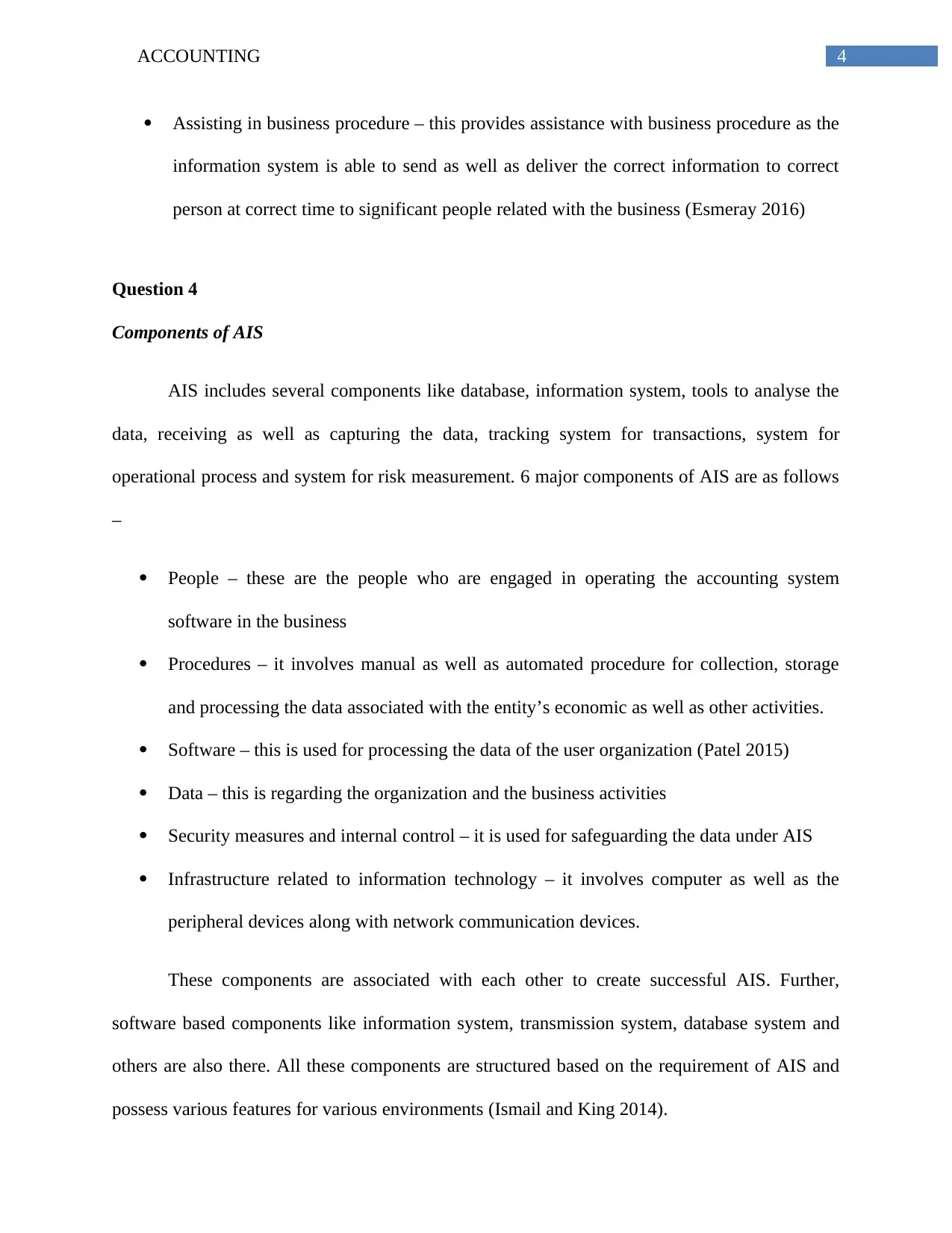
4ACCOUNTING
Assisting in business procedure – this provides assistance with business procedure as the
information system is able to send as well as deliver the correct information to correct
person at correct time to significant people related with the business (Esmeray 2016)
Question 4
Components of AIS
AIS includes several components like database, information system, tools to analyse the
data, receiving as well as capturing the data, tracking system for transactions, system for
operational process and system for risk measurement. 6 major components of AIS are as follows
–
People – these are the people who are engaged in operating the accounting system
software in the business
Procedures – it involves manual as well as automated procedure for collection, storage
and processing the data associated with the entity’s economic as well as other activities.
Software – this is used for processing the data of the user organization (Patel 2015)
Data – this is regarding the organization and the business activities
Security measures and internal control – it is used for safeguarding the data under AIS
Infrastructure related to information technology – it involves computer as well as the
peripheral devices along with network communication devices.
These components are associated with each other to create successful AIS. Further,
software based components like information system, transmission system, database system and
others are also there. All these components are structured based on the requirement of AIS and
possess various features for various environments (Ismail and King 2014).
Assisting in business procedure – this provides assistance with business procedure as the
information system is able to send as well as deliver the correct information to correct
person at correct time to significant people related with the business (Esmeray 2016)
Question 4
Components of AIS
AIS includes several components like database, information system, tools to analyse the
data, receiving as well as capturing the data, tracking system for transactions, system for
operational process and system for risk measurement. 6 major components of AIS are as follows
–
People – these are the people who are engaged in operating the accounting system
software in the business
Procedures – it involves manual as well as automated procedure for collection, storage
and processing the data associated with the entity’s economic as well as other activities.
Software – this is used for processing the data of the user organization (Patel 2015)
Data – this is regarding the organization and the business activities
Security measures and internal control – it is used for safeguarding the data under AIS
Infrastructure related to information technology – it involves computer as well as the
peripheral devices along with network communication devices.
These components are associated with each other to create successful AIS. Further,
software based components like information system, transmission system, database system and
others are also there. All these components are structured based on the requirement of AIS and
possess various features for various environments (Ismail and King 2014).
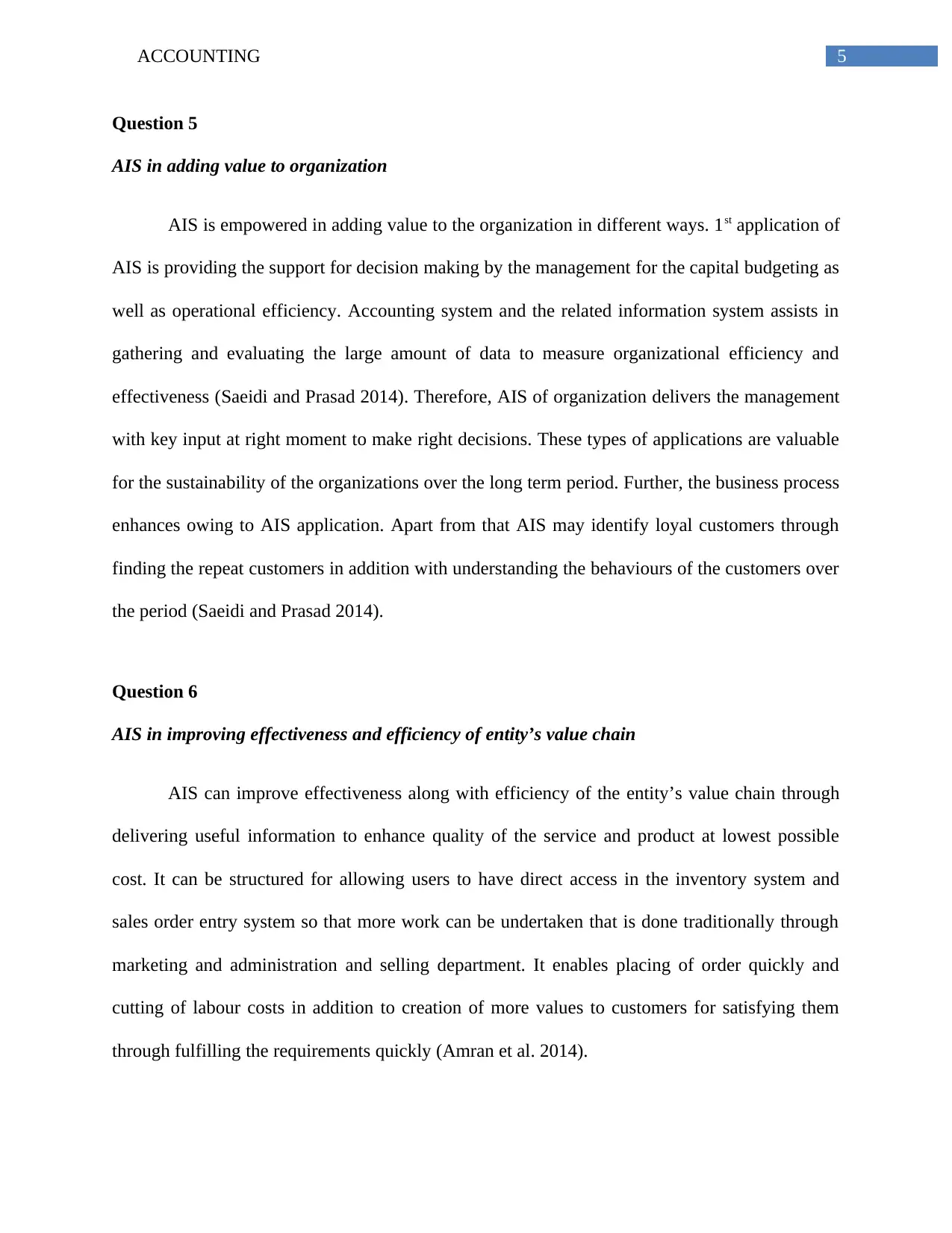
5ACCOUNTING
Question 5
AIS in adding value to organization
AIS is empowered in adding value to the organization in different ways. 1st application of
AIS is providing the support for decision making by the management for the capital budgeting as
well as operational efficiency. Accounting system and the related information system assists in
gathering and evaluating the large amount of data to measure organizational efficiency and
effectiveness (Saeidi and Prasad 2014). Therefore, AIS of organization delivers the management
with key input at right moment to make right decisions. These types of applications are valuable
for the sustainability of the organizations over the long term period. Further, the business process
enhances owing to AIS application. Apart from that AIS may identify loyal customers through
finding the repeat customers in addition with understanding the behaviours of the customers over
the period (Saeidi and Prasad 2014).
Question 6
AIS in improving effectiveness and efficiency of entity’s value chain
AIS can improve effectiveness along with efficiency of the entity’s value chain through
delivering useful information to enhance quality of the service and product at lowest possible
cost. It can be structured for allowing users to have direct access in the inventory system and
sales order entry system so that more work can be undertaken that is done traditionally through
marketing and administration and selling department. It enables placing of order quickly and
cutting of labour costs in addition to creation of more values to customers for satisfying them
through fulfilling the requirements quickly (Amran et al. 2014).
Question 5
AIS in adding value to organization
AIS is empowered in adding value to the organization in different ways. 1st application of
AIS is providing the support for decision making by the management for the capital budgeting as
well as operational efficiency. Accounting system and the related information system assists in
gathering and evaluating the large amount of data to measure organizational efficiency and
effectiveness (Saeidi and Prasad 2014). Therefore, AIS of organization delivers the management
with key input at right moment to make right decisions. These types of applications are valuable
for the sustainability of the organizations over the long term period. Further, the business process
enhances owing to AIS application. Apart from that AIS may identify loyal customers through
finding the repeat customers in addition with understanding the behaviours of the customers over
the period (Saeidi and Prasad 2014).
Question 6
AIS in improving effectiveness and efficiency of entity’s value chain
AIS can improve effectiveness along with efficiency of the entity’s value chain through
delivering useful information to enhance quality of the service and product at lowest possible
cost. It can be structured for allowing users to have direct access in the inventory system and
sales order entry system so that more work can be undertaken that is done traditionally through
marketing and administration and selling department. It enables placing of order quickly and
cutting of labour costs in addition to creation of more values to customers for satisfying them
through fulfilling the requirements quickly (Amran et al. 2014).
⊘ This is a preview!⊘
Do you want full access?
Subscribe today to unlock all pages.

Trusted by 1+ million students worldwide
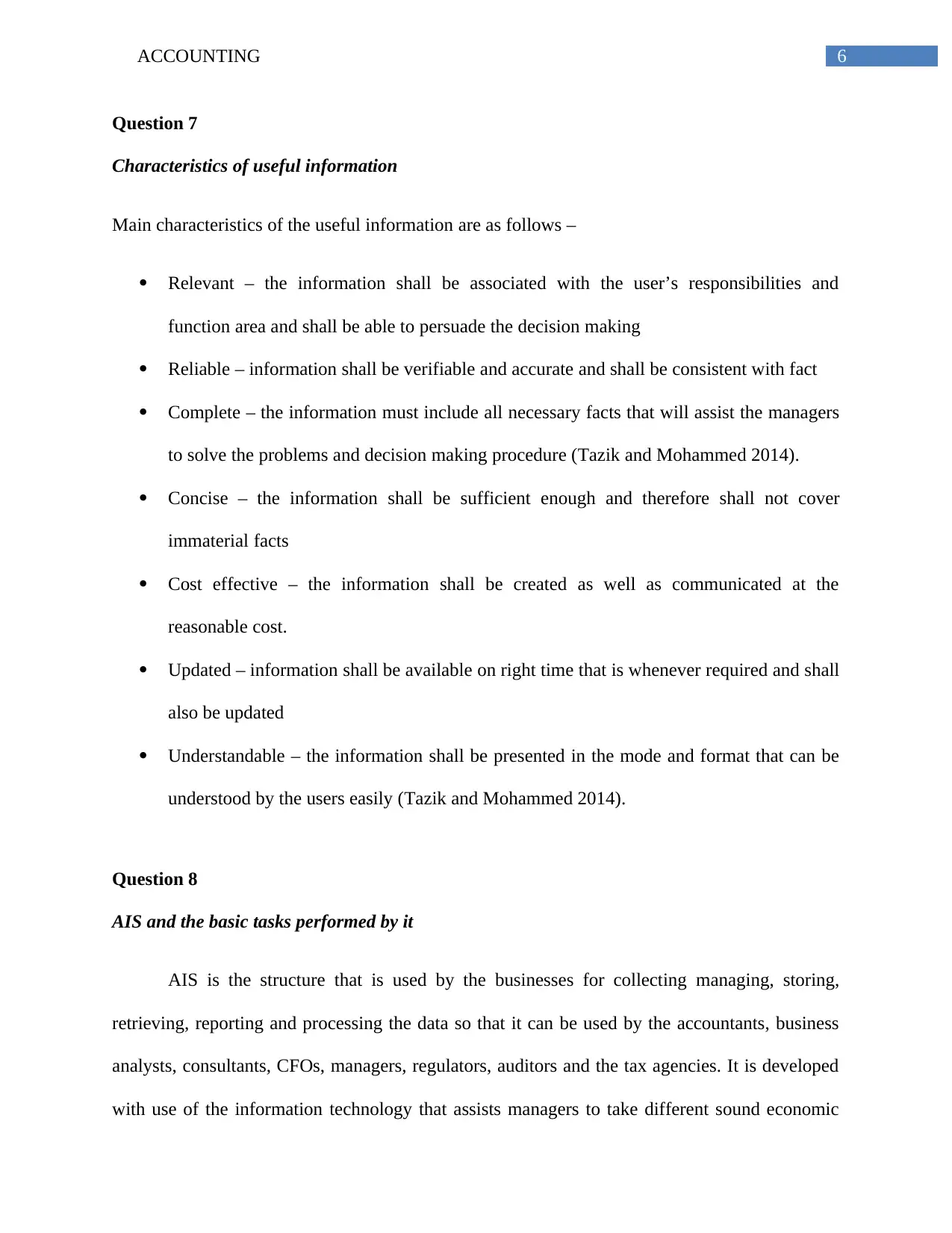
6ACCOUNTING
Question 7
Characteristics of useful information
Main characteristics of the useful information are as follows –
Relevant – the information shall be associated with the user’s responsibilities and
function area and shall be able to persuade the decision making
Reliable – information shall be verifiable and accurate and shall be consistent with fact
Complete – the information must include all necessary facts that will assist the managers
to solve the problems and decision making procedure (Tazik and Mohammed 2014).
Concise – the information shall be sufficient enough and therefore shall not cover
immaterial facts
Cost effective – the information shall be created as well as communicated at the
reasonable cost.
Updated – information shall be available on right time that is whenever required and shall
also be updated
Understandable – the information shall be presented in the mode and format that can be
understood by the users easily (Tazik and Mohammed 2014).
Question 8
AIS and the basic tasks performed by it
AIS is the structure that is used by the businesses for collecting managing, storing,
retrieving, reporting and processing the data so that it can be used by the accountants, business
analysts, consultants, CFOs, managers, regulators, auditors and the tax agencies. It is developed
with use of the information technology that assists managers to take different sound economic
Question 7
Characteristics of useful information
Main characteristics of the useful information are as follows –
Relevant – the information shall be associated with the user’s responsibilities and
function area and shall be able to persuade the decision making
Reliable – information shall be verifiable and accurate and shall be consistent with fact
Complete – the information must include all necessary facts that will assist the managers
to solve the problems and decision making procedure (Tazik and Mohammed 2014).
Concise – the information shall be sufficient enough and therefore shall not cover
immaterial facts
Cost effective – the information shall be created as well as communicated at the
reasonable cost.
Updated – information shall be available on right time that is whenever required and shall
also be updated
Understandable – the information shall be presented in the mode and format that can be
understood by the users easily (Tazik and Mohammed 2014).
Question 8
AIS and the basic tasks performed by it
AIS is the structure that is used by the businesses for collecting managing, storing,
retrieving, reporting and processing the data so that it can be used by the accountants, business
analysts, consultants, CFOs, managers, regulators, auditors and the tax agencies. It is developed
with use of the information technology that assists managers to take different sound economic
Paraphrase This Document
Need a fresh take? Get an instant paraphrase of this document with our AI Paraphraser
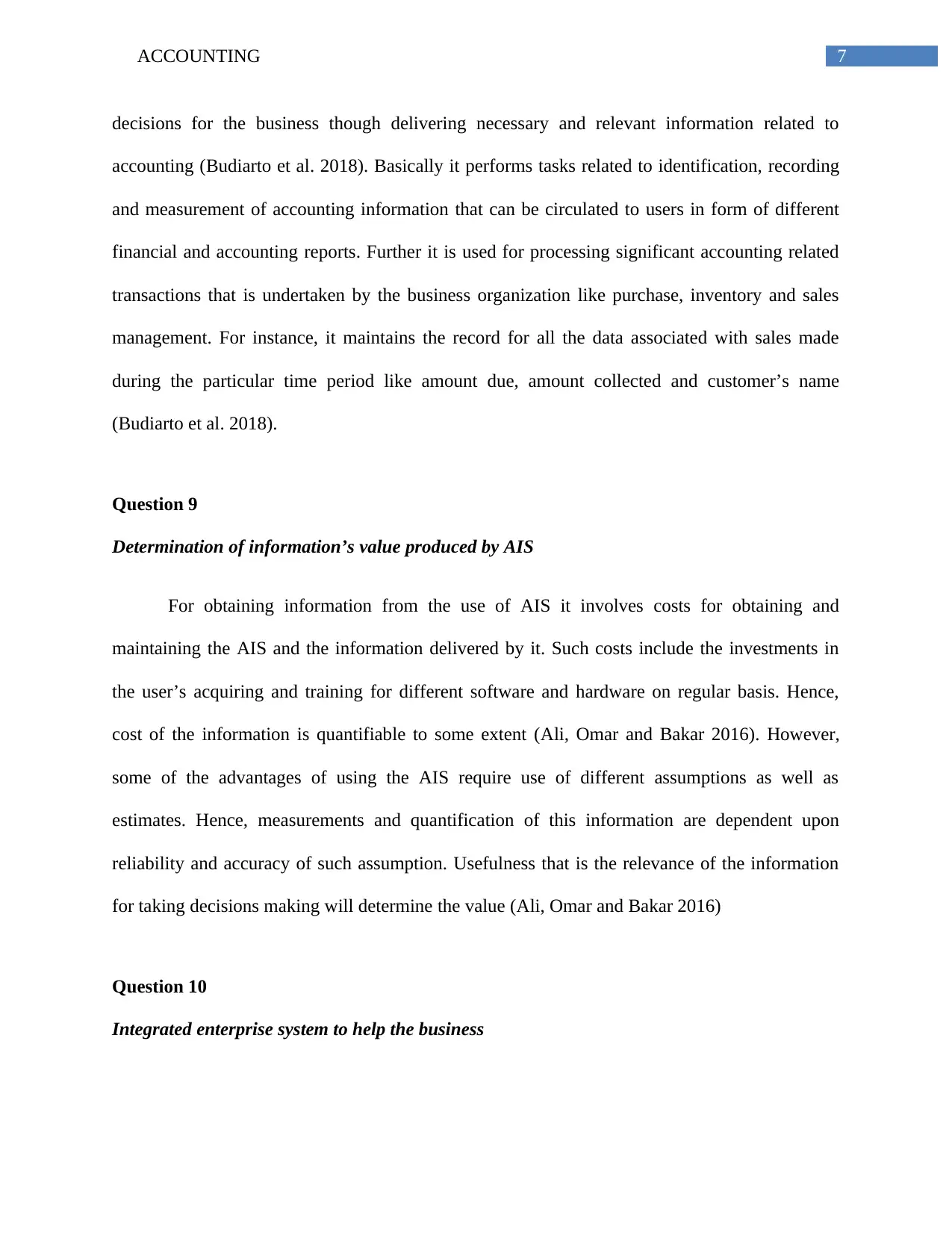
7ACCOUNTING
decisions for the business though delivering necessary and relevant information related to
accounting (Budiarto et al. 2018). Basically it performs tasks related to identification, recording
and measurement of accounting information that can be circulated to users in form of different
financial and accounting reports. Further it is used for processing significant accounting related
transactions that is undertaken by the business organization like purchase, inventory and sales
management. For instance, it maintains the record for all the data associated with sales made
during the particular time period like amount due, amount collected and customer’s name
(Budiarto et al. 2018).
Question 9
Determination of information’s value produced by AIS
For obtaining information from the use of AIS it involves costs for obtaining and
maintaining the AIS and the information delivered by it. Such costs include the investments in
the user’s acquiring and training for different software and hardware on regular basis. Hence,
cost of the information is quantifiable to some extent (Ali, Omar and Bakar 2016). However,
some of the advantages of using the AIS require use of different assumptions as well as
estimates. Hence, measurements and quantification of this information are dependent upon
reliability and accuracy of such assumption. Usefulness that is the relevance of the information
for taking decisions making will determine the value (Ali, Omar and Bakar 2016)
Question 10
Integrated enterprise system to help the business
decisions for the business though delivering necessary and relevant information related to
accounting (Budiarto et al. 2018). Basically it performs tasks related to identification, recording
and measurement of accounting information that can be circulated to users in form of different
financial and accounting reports. Further it is used for processing significant accounting related
transactions that is undertaken by the business organization like purchase, inventory and sales
management. For instance, it maintains the record for all the data associated with sales made
during the particular time period like amount due, amount collected and customer’s name
(Budiarto et al. 2018).
Question 9
Determination of information’s value produced by AIS
For obtaining information from the use of AIS it involves costs for obtaining and
maintaining the AIS and the information delivered by it. Such costs include the investments in
the user’s acquiring and training for different software and hardware on regular basis. Hence,
cost of the information is quantifiable to some extent (Ali, Omar and Bakar 2016). However,
some of the advantages of using the AIS require use of different assumptions as well as
estimates. Hence, measurements and quantification of this information are dependent upon
reliability and accuracy of such assumption. Usefulness that is the relevance of the information
for taking decisions making will determine the value (Ali, Omar and Bakar 2016)
Question 10
Integrated enterprise system to help the business
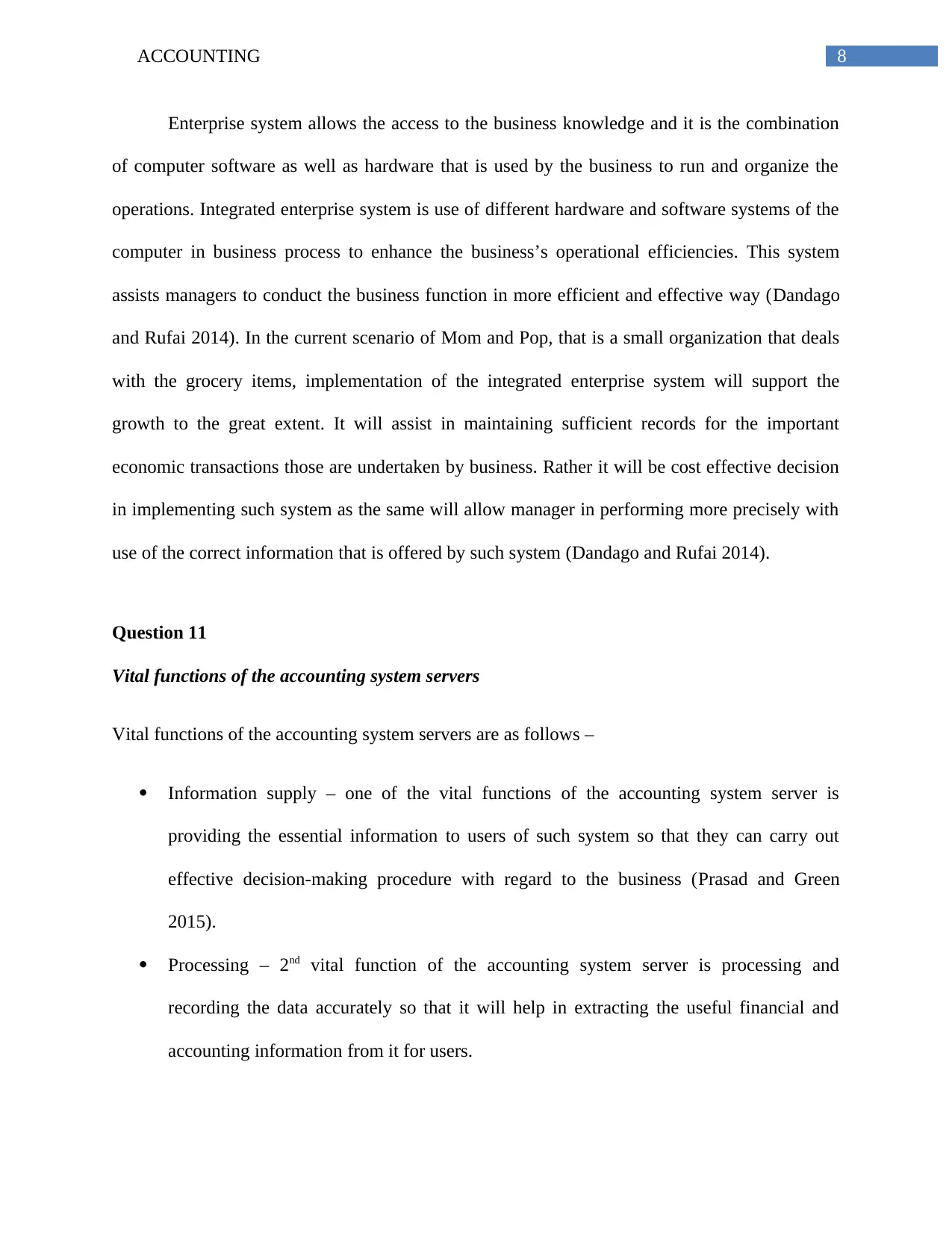
8ACCOUNTING
Enterprise system allows the access to the business knowledge and it is the combination
of computer software as well as hardware that is used by the business to run and organize the
operations. Integrated enterprise system is use of different hardware and software systems of the
computer in business process to enhance the business’s operational efficiencies. This system
assists managers to conduct the business function in more efficient and effective way (Dandago
and Rufai 2014). In the current scenario of Mom and Pop, that is a small organization that deals
with the grocery items, implementation of the integrated enterprise system will support the
growth to the great extent. It will assist in maintaining sufficient records for the important
economic transactions those are undertaken by business. Rather it will be cost effective decision
in implementing such system as the same will allow manager in performing more precisely with
use of the correct information that is offered by such system (Dandago and Rufai 2014).
Question 11
Vital functions of the accounting system servers
Vital functions of the accounting system servers are as follows –
Information supply – one of the vital functions of the accounting system server is
providing the essential information to users of such system so that they can carry out
effective decision-making procedure with regard to the business (Prasad and Green
2015).
Processing – 2nd vital function of the accounting system server is processing and
recording the data accurately so that it will help in extracting the useful financial and
accounting information from it for users.
Enterprise system allows the access to the business knowledge and it is the combination
of computer software as well as hardware that is used by the business to run and organize the
operations. Integrated enterprise system is use of different hardware and software systems of the
computer in business process to enhance the business’s operational efficiencies. This system
assists managers to conduct the business function in more efficient and effective way (Dandago
and Rufai 2014). In the current scenario of Mom and Pop, that is a small organization that deals
with the grocery items, implementation of the integrated enterprise system will support the
growth to the great extent. It will assist in maintaining sufficient records for the important
economic transactions those are undertaken by business. Rather it will be cost effective decision
in implementing such system as the same will allow manager in performing more precisely with
use of the correct information that is offered by such system (Dandago and Rufai 2014).
Question 11
Vital functions of the accounting system servers
Vital functions of the accounting system servers are as follows –
Information supply – one of the vital functions of the accounting system server is
providing the essential information to users of such system so that they can carry out
effective decision-making procedure with regard to the business (Prasad and Green
2015).
Processing – 2nd vital function of the accounting system server is processing and
recording the data accurately so that it will help in extracting the useful financial and
accounting information from it for users.
⊘ This is a preview!⊘
Do you want full access?
Subscribe today to unlock all pages.

Trusted by 1+ million students worldwide
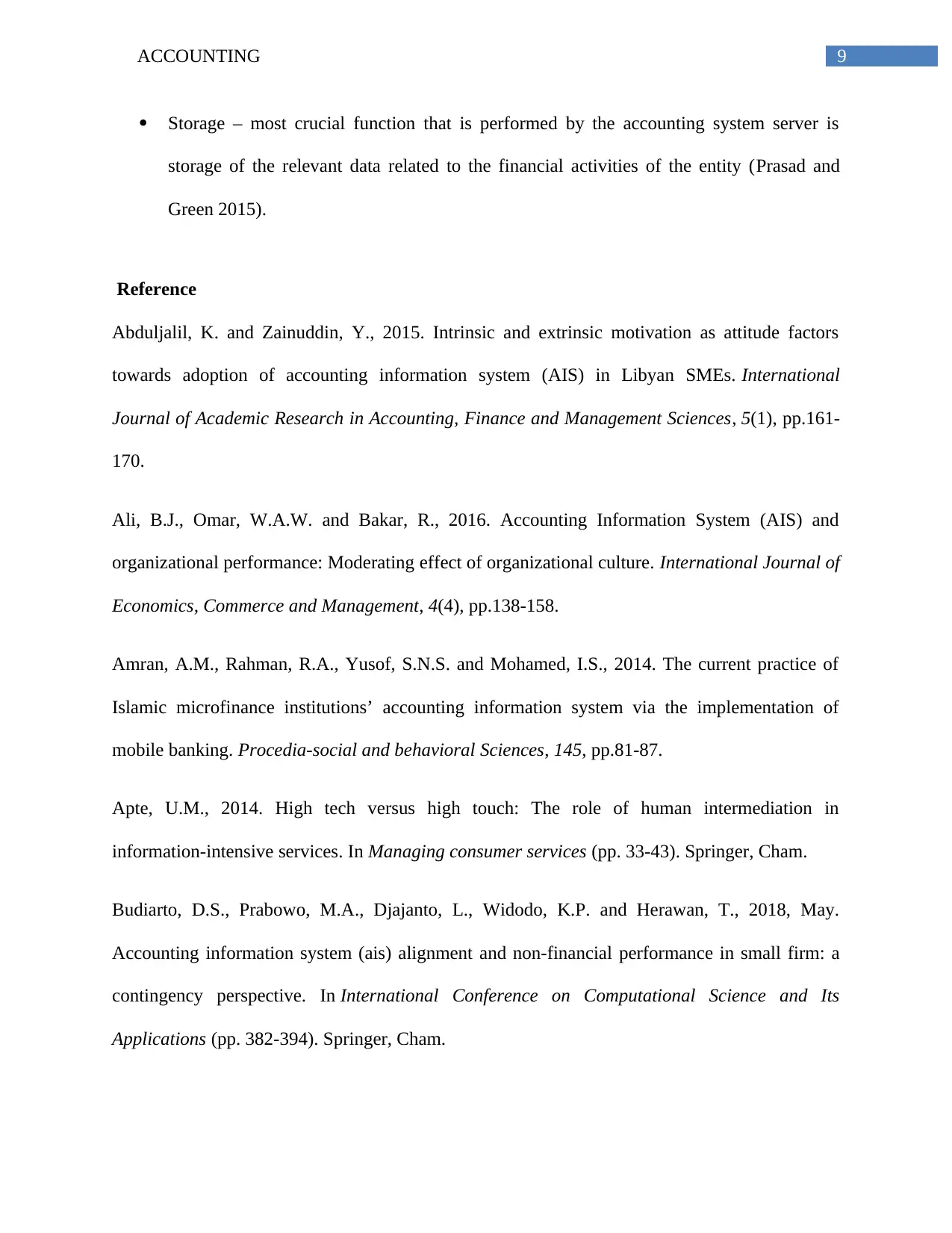
9ACCOUNTING
Storage – most crucial function that is performed by the accounting system server is
storage of the relevant data related to the financial activities of the entity (Prasad and
Green 2015).
Reference
Abduljalil, K. and Zainuddin, Y., 2015. Intrinsic and extrinsic motivation as attitude factors
towards adoption of accounting information system (AIS) in Libyan SMEs. International
Journal of Academic Research in Accounting, Finance and Management Sciences, 5(1), pp.161-
170.
Ali, B.J., Omar, W.A.W. and Bakar, R., 2016. Accounting Information System (AIS) and
organizational performance: Moderating effect of organizational culture. International Journal of
Economics, Commerce and Management, 4(4), pp.138-158.
Amran, A.M., Rahman, R.A., Yusof, S.N.S. and Mohamed, I.S., 2014. The current practice of
Islamic microfinance institutions’ accounting information system via the implementation of
mobile banking. Procedia-social and behavioral Sciences, 145, pp.81-87.
Apte, U.M., 2014. High tech versus high touch: The role of human intermediation in
information-intensive services. In Managing consumer services (pp. 33-43). Springer, Cham.
Budiarto, D.S., Prabowo, M.A., Djajanto, L., Widodo, K.P. and Herawan, T., 2018, May.
Accounting information system (ais) alignment and non-financial performance in small firm: a
contingency perspective. In International Conference on Computational Science and Its
Applications (pp. 382-394). Springer, Cham.
Storage – most crucial function that is performed by the accounting system server is
storage of the relevant data related to the financial activities of the entity (Prasad and
Green 2015).
Reference
Abduljalil, K. and Zainuddin, Y., 2015. Intrinsic and extrinsic motivation as attitude factors
towards adoption of accounting information system (AIS) in Libyan SMEs. International
Journal of Academic Research in Accounting, Finance and Management Sciences, 5(1), pp.161-
170.
Ali, B.J., Omar, W.A.W. and Bakar, R., 2016. Accounting Information System (AIS) and
organizational performance: Moderating effect of organizational culture. International Journal of
Economics, Commerce and Management, 4(4), pp.138-158.
Amran, A.M., Rahman, R.A., Yusof, S.N.S. and Mohamed, I.S., 2014. The current practice of
Islamic microfinance institutions’ accounting information system via the implementation of
mobile banking. Procedia-social and behavioral Sciences, 145, pp.81-87.
Apte, U.M., 2014. High tech versus high touch: The role of human intermediation in
information-intensive services. In Managing consumer services (pp. 33-43). Springer, Cham.
Budiarto, D.S., Prabowo, M.A., Djajanto, L., Widodo, K.P. and Herawan, T., 2018, May.
Accounting information system (ais) alignment and non-financial performance in small firm: a
contingency perspective. In International Conference on Computational Science and Its
Applications (pp. 382-394). Springer, Cham.
Paraphrase This Document
Need a fresh take? Get an instant paraphrase of this document with our AI Paraphraser
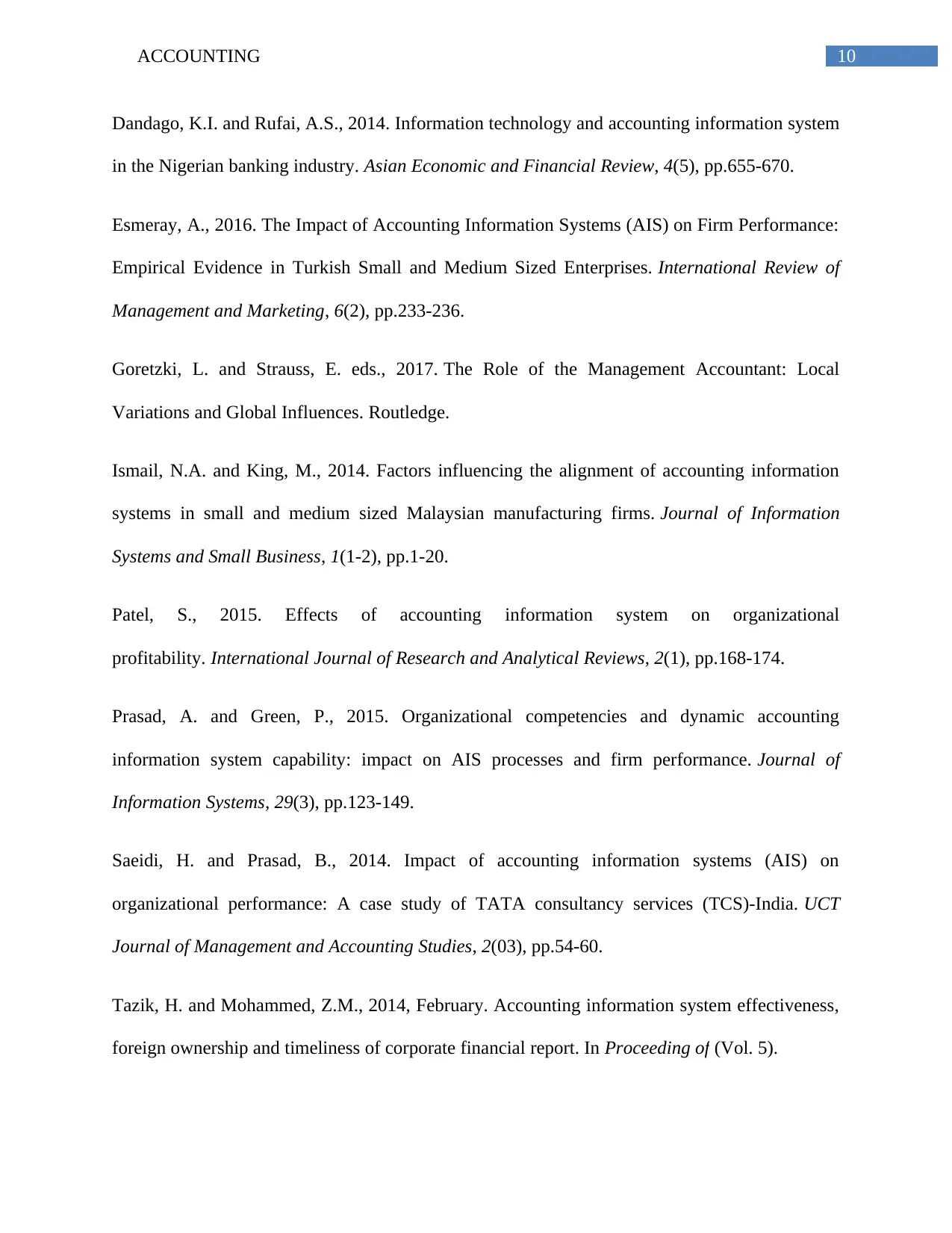
10ACCOUNTING
Dandago, K.I. and Rufai, A.S., 2014. Information technology and accounting information system
in the Nigerian banking industry. Asian Economic and Financial Review, 4(5), pp.655-670.
Esmeray, A., 2016. The Impact of Accounting Information Systems (AIS) on Firm Performance:
Empirical Evidence in Turkish Small and Medium Sized Enterprises. International Review of
Management and Marketing, 6(2), pp.233-236.
Goretzki, L. and Strauss, E. eds., 2017. The Role of the Management Accountant: Local
Variations and Global Influences. Routledge.
Ismail, N.A. and King, M., 2014. Factors influencing the alignment of accounting information
systems in small and medium sized Malaysian manufacturing firms. Journal of Information
Systems and Small Business, 1(1-2), pp.1-20.
Patel, S., 2015. Effects of accounting information system on organizational
profitability. International Journal of Research and Analytical Reviews, 2(1), pp.168-174.
Prasad, A. and Green, P., 2015. Organizational competencies and dynamic accounting
information system capability: impact on AIS processes and firm performance. Journal of
Information Systems, 29(3), pp.123-149.
Saeidi, H. and Prasad, B., 2014. Impact of accounting information systems (AIS) on
organizational performance: A case study of TATA consultancy services (TCS)-India. UCT
Journal of Management and Accounting Studies, 2(03), pp.54-60.
Tazik, H. and Mohammed, Z.M., 2014, February. Accounting information system effectiveness,
foreign ownership and timeliness of corporate financial report. In Proceeding of (Vol. 5).
Dandago, K.I. and Rufai, A.S., 2014. Information technology and accounting information system
in the Nigerian banking industry. Asian Economic and Financial Review, 4(5), pp.655-670.
Esmeray, A., 2016. The Impact of Accounting Information Systems (AIS) on Firm Performance:
Empirical Evidence in Turkish Small and Medium Sized Enterprises. International Review of
Management and Marketing, 6(2), pp.233-236.
Goretzki, L. and Strauss, E. eds., 2017. The Role of the Management Accountant: Local
Variations and Global Influences. Routledge.
Ismail, N.A. and King, M., 2014. Factors influencing the alignment of accounting information
systems in small and medium sized Malaysian manufacturing firms. Journal of Information
Systems and Small Business, 1(1-2), pp.1-20.
Patel, S., 2015. Effects of accounting information system on organizational
profitability. International Journal of Research and Analytical Reviews, 2(1), pp.168-174.
Prasad, A. and Green, P., 2015. Organizational competencies and dynamic accounting
information system capability: impact on AIS processes and firm performance. Journal of
Information Systems, 29(3), pp.123-149.
Saeidi, H. and Prasad, B., 2014. Impact of accounting information systems (AIS) on
organizational performance: A case study of TATA consultancy services (TCS)-India. UCT
Journal of Management and Accounting Studies, 2(03), pp.54-60.
Tazik, H. and Mohammed, Z.M., 2014, February. Accounting information system effectiveness,
foreign ownership and timeliness of corporate financial report. In Proceeding of (Vol. 5).
1 out of 11
Related Documents
Your All-in-One AI-Powered Toolkit for Academic Success.
+13062052269
info@desklib.com
Available 24*7 on WhatsApp / Email
![[object Object]](/_next/static/media/star-bottom.7253800d.svg)
Unlock your academic potential
Copyright © 2020–2025 A2Z Services. All Rights Reserved. Developed and managed by ZUCOL.




